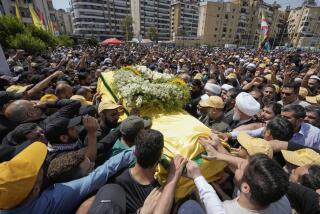Pakistani Taliban confirms leader’s death
- Share via
Reporting from Islamabad, Pakistan — The Pakistani Taliban confirmed Tuesday that its leader, Hakimullah Mahsud, has died from injuries suffered in a U.S. drone missile strike last month, forcing the insurgency to find a new leader for the second time in six months.
The death of Mahsud, engineer of a devastating series of suicide attacks and raids on markets, mosques and security installations across Pakistan late last year, gives the United States another major victory in its campaign of missile strikes against top Taliban and Al Qaeda leaders.
A drone strike in August killed Mahsud’s predecessor, Baitullah Mahsud. Missiles fired by drones over Pakistan’s tribal areas along the Afghan border have also killed 15 senior Al Qaeda commanders since 2004.
However, experts do not expect the loss of Hakimullah Mahsud, 28, to deal a fatal blow to the Taliban as it battles the government in the country’s northwest.
After Baitullah Mahsud’s death last summer, the Taliban was able to regroup and launch some of the deadliest attacks against Pakistanis in years, including the Oct. 10 commando-style raid against the army headquarters in Rawalpindi, a sprawling and heavily guarded complex. The attack left 14 military officers and civilian workers dead.
“Obviously, it’s a great setback for them in terms of morale and organizational problems. There’s no doubt about it,” said Talat Masood, a security analyst and retired Pakistani general. “It will take time for them to recover, but they will definitely recover because they have support in those tribal areas.”
Pakistani authorities initially believed that Mahsud had been injured in a Jan. 17 U.S. drone strike that targeted two cars in North Waziristan, a largely Taliban-controlled district in the tribal areas.
However, Taliban sources said their leader was wounded in a drone strike Jan. 14 in Shaktoi, a village in South Waziristan near the North Waziristan border. A Taliban militant in the Orakzai district of Pakistan’s tribal areas said Mahsud suffered serious injuries to his legs and abdomen in the attack.
The sources said militants were trying to move Mahsud to Pakistan’s largest city, Karachi, for treatment but he died near the southern Punjab province city of Multan, 460 miles northeast of his destination.
Taliban sources said he died Sunday, though that could not be confirmed.
Pakistani security and intelligence sources confirmed Mahsud’s death, but denied that he died in Multan and instead said he died somewhere in the tribal region. The military had announced late last month that it was looking into reports that the Taliban chief had been killed.
The missile strike that killed Mahsud came amid a sharp rise in U.S. drone activity in the tribal areas after the Dec. 30 suicide bombing of a secret base in the eastern Afghan province of Khowst in which seven CIA employees and contractors were killed. Since that attack, at least a dozen drone strikes have hit northwest Pakistan, killing at least 100 people.
In a video released after the base attack, Mahsud was seen seated next to the Jordanian who carried out the bombing. The bomber, Humam Khalil Abu-Mulal Balawi, said the attack he was planning would avenge the killing of Baitullah Mahsud.
The Taliban has not named Hakimullah Mahsud’s successor. However, the likeliest candidate appears to be Noor Jamal, the Taliban’s commander in Orakzai and the neighboring Kurram tribal region and reportedly a close ally of Mahsud.
Believed to be in his 30s, Jamal is thought to be responsible for numerous kidnappings and slayings of pro-government tribal elders and informants. Also known as Mullah Tufan, Jamal ran a madrasa, or religious school, in the Togh Surai area of Orakzai before joining the Taliban.
Masood, the retired general, said he doubted that Hakimullah Mahsud’s deputy, Wali-ur Rehman, would be selected as the new Taliban chief because he is based in South Waziristan, where a large-scale offensive by Pakistani troops has devastated the Taliban’s infrastructure of camps, bunkers and compounds.
Orakzai and Kurram, meanwhile, have become more important to the Taliban because they are key tribal districts to which militant leaders and fighters have been escaping after fleeing South Waziristan. Villagers in those districts say militants have begun patrolling areas they control and setting up checkpoints.
If Jamal becomes the Taliban’s leader, Masood said, he probably will try to assert himself the way Mahsud did, by unleashing a wave of suicide bombings aimed at portraying the insurgency as a viable, deadly force undaunted by the military’s advances in the tribal areas.
The difference between the Taliban that Mahsud inherited and the one Jamal would oversee is that the insurgents’ capability to train and equip attackers has been significantly damaged by the Pakistani military’s offensive in South Waziristan.
“The question is to what extent do they have people ready to do this,” Masood said. “The more you clear militant sanctuaries and camps, the less ability they have to launch these attacks. They’d like to replicate what they did after Baitullah Mahsud died, but their capability is much less now.”
alex.rodriguez
@latimes.com
Special correspondent Zulfiqar Ali in Peshawar, Pakistan, contributed to this report.
More to Read
Sign up for Essential California
The most important California stories and recommendations in your inbox every morning.
You may occasionally receive promotional content from the Los Angeles Times.










